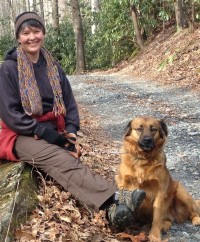Last week I told you about the sweet gum tree and how it’s role as food for finches and luna moths put it on the WILL-plant list for Five Apple Farm. But wait, there’s more!
Besides being in love with my copy of The Living Landscape by Rick Darke and Doug Tallamy, I am also in love with my newest book Medicinal Plants of the Southern Appalachians by the amazing herbalist Patricia Kyritsi Howell. (I have the Organic Growers School to thank for the day long class with Howell — one of the best herb classes I’ve ever attended.)
I’m amazed at how many trees, shrubs and plants appear in both books! Turns out the native plants that are so critical for the survival of songbirds, butterflies, bees etc just happen to be a treasure trove of herbal medicines. Larrapin overload!
And when you hear that native plants, in general, offer more to the ecosystem….we’re not talking by a little. It’s a lot. The chart above (from The Living Landscape) is a good visual on this. The green bar is the number of caterpillar species on average native woody plants support vs the non-native in orange.
Why would we want caterpillars? Caterpillars (and other insects) are what baby birds are built of! This is just one example and I could go on and on…but the more I understand how densely connected are the strands of the web of life—the more I’m falling in love with native plants and all their gifts.
Let me be clear, while I do my best to avoid invasive plants, I plant MANY things that are non-native and will continue to do so…for food, fruit and beauty too. It’s a real perk of having a lot of open ground to plant as well as a diverse natural landscape surrounding the farm.
Still, I find more enamored of native plants as I begin to understand — and see with my own eyes — what a difference they make. If I lived in a city, a suburb or a place with little wild land then planting natives is a very big deal. It’s throwing out a lifeline to the creatures trying to live among us or just trying to get to the other side of the metro area packed with inedible ornamental plants. (Pic below from Darke’s book: natural beauty and natural beauties).
And as IF that all wasn’t enough—when I plant natives I also happen to be surrounding myself with a natural pharmacy. This is something our ancestors and first peoples knew well. For example, here are some of the sweet gum’s offerings (from Howell’s book):
How cool is that! [Leigh puts a big *star* beside the tree on the will-plant list…] I know making potions from the land you live on is a special kind of satisfying and to feel strengthened by them somehow feels like coming full circle. Do try this at home. Plant it and they will come. No kidding. More on that and on Howell’s most excellent book in future posts.
with love, Leigh
———————-
I would love to have you as a regular reader! Subscribe to get one email a week (max) about the larrapin goings-on at Five Apple Farm as well as keeping up with those fuzzy darlings who make your favorite honey. Occasional garden book giveaways too. It’s all free of course and your info isn’t shared. There’s also the Facebook page, Pinterest boards and even Instagram now and then. Fun aplenty. Enjoy.









